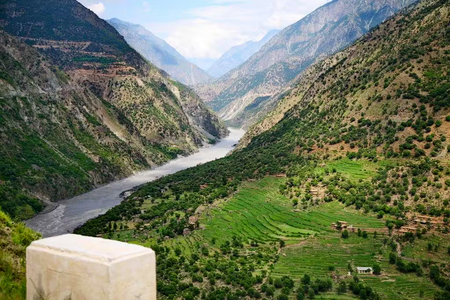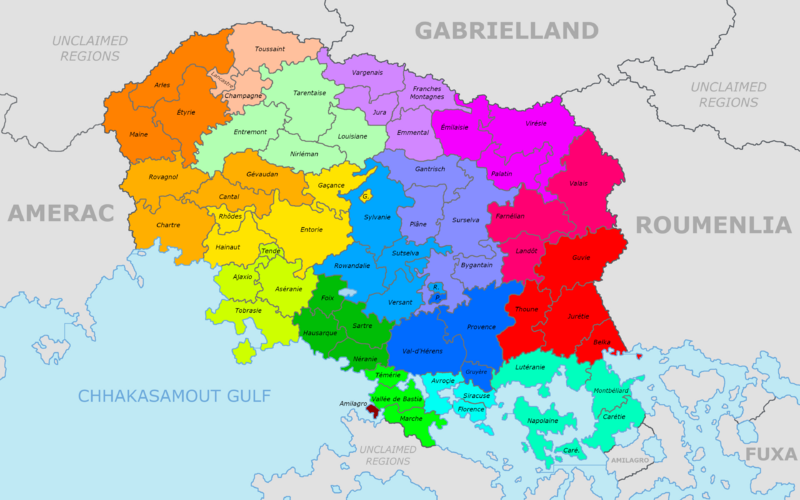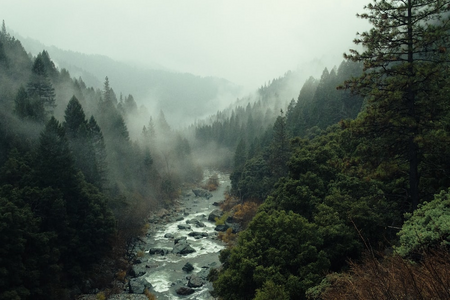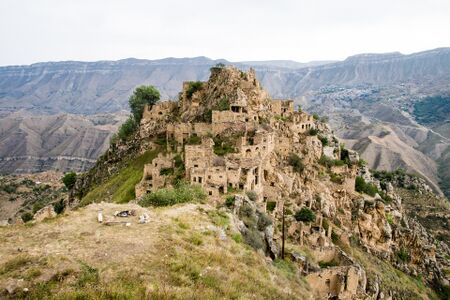Vileria
This page is being repurposed, do not delete, modify or add content |
This article is incomplete because it is pending further input from participants, or it is a work-in-progress by one author. Please comment on this article's talk page to share your input, comments and questions. Note: To contribute to this article, you may need to seek help from the author(s) of this page. |
Empire of Vileria Empire de Vilérie (Viresian) | |
|---|---|
| Anthem: Our National Pride | |
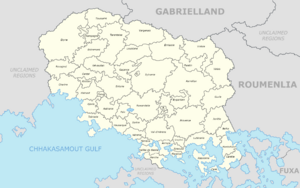 | |
| Capital | Florence |
| Largest | Ravena |
| Official languages | Viresian |
| Recognised regional languages | Cantalian Entorian Tmetaman Juretian Toussainese Tiverian |
| Ethnic groups (2022) | 45%: Viresian 30%: Eralian 12.5%: Etyrian 7.3%: Aserania 4.7%: Florentian 0.5%: Other |
| Religion (2022) | Vilerianism (State religion) |
| Demonym(s) | Vilerian |
| Government | Federal semi-theocratic parliamentary monarchy |
• Empress | Victoire I |
| Robin Delapart | |
| Legislature | Imperial Congress |
| Imperial Council | |
| House of Peers | |
| Establishment | |
| ~4500 BCE | |
| ~3000 BCE | |
| Area | |
• | 1,766,208 km2 (681,937 sq mi) |
| Population | |
• 2023 estimate | 31,026,524 |
• Density | 17.6/km2 (45.6/sq mi) |
| GDP (nominal) | 2021 estimate |
• Total | 1.744 trillion VRF. (2.004 tillion ACU) |
• Per capita | 56,203 VRF. (64,596.02 ACU) |
| Currency | Vilerian Franc (VRF.) |
| Time zone | UTC-5 (UTC) |
| Date format | DD.MM.YYYY |
| Driving side | right |
| Calling code | +755 |
| ISO 3166 code | VR |
| Internet TLD | .vr |
Vileria, officially known as the Vilerian Empire or Empire of Vileria is an Empire located on the Canton Delta and the South-Eastern regions of Thuadia, bordered by sea by the Chhakasamout Gulf giving it access to the oceans. It is land-bordered by Recadrer to the south through the Western Canton Delta, Amerac to the west through the Chhakasamout Gulf's coasts and mountains, Salerit to the east by the Eastern Alps, Gabrielland to the north through the Northern Alps and Galicianna to the south-east through the Central Canton Delta and a small expanse of the Eastern Alps. It possesses over a lot of smaller islands through the Canton Delta, including the Napolaine Islands Archipelago where the Duchy of Napolaine lies in the Western Basin, the main island of Napolaine being the biggest island possessed by the Empire with the Caoso Tobran Island in the Duchy of Tobrasie. The total land area claimed by the Empire of Vileria is about 1,766,208 square kilometers.
Vileria's history dates back to about 900,000 years ago with the first humans occupying the northern parts including the Northern Alps where the Republic of the Franches Montagnes, the Archduchy of Toussaint and the Kingdom of Viresia lie. Vileria is geographically divided among the Etyrian Alps, Viresian Alps, Sylvanian Forests, Entorian Forests, Tobrasian Coast, Temerian Delta and the Canton Delta; the Alps occupy the majority of the territory, its highest peak being Mount Hausos, at 6715 meters high, the country has more than 200 distinct peaks over 4000 meters and 40 distinct peaks over 6000 meters. The Alps concentrate about 25% of the entire population as the Vilerians were mountain people since the State of Viqueïas, the central lands concentrate about 60% of the population and the Canton Delta the rest, or about 15% of the population. Vileria is not very urbanized as most people live in rural areas, hence creating a lot of villages and stops. Vileria originates from the Early Vilerian Empire which was declared around 5000 years BCE. The country is inhabited by about 118 million souls as of 2023, it exports mostly cars, electrical cars and commercial planes, most from the Citroën and Peugeot brands, it also exports a massive amount of woodchips and oil.
History
Early History
Vikays people
Main article: Vicaïs culture, Vicaïs people
The Vikays people are an evolution of the Proto-Thrismario-Thuadians, they migrated from what is now the areas north of where are currently located Galeteri and Foxomexra, they established a first state which used to lie in the Al-Najma Mountains, it survived and thrived for about 400 years from 5450 to 5050 BCE. Most of it was mountainous but the western areas, south-west of Fuxa, were very erable, where most could also be used for cattle farming, mostly cows.
The late Vikays culture established itself in the banks and coasts of the current constituent states of Luterania, southern Belka, Temeria and the Kingdom of Florence establishing the first states that would come to form the early Empire of Vileria.
The Eight Kingdoms
Main article: The Eight Kingdoms
The Eight Kingdoms era was a period of Vilerian history that lasted from the 50th century BCE to the 42nd century BCE, it's considered the most important period in Vilerian history because it marked the point when Vileria would finally start uniting.
Sanrho Period (4990BCE–4771BCE)
The Kingdom of Valais, the first of two, would be one of the most influencial states of the early Eight Kingdoms period, it was the most prosperous with a thriving economy and culture which extended from the upper Valais mountains to the lower Farnélian Expanse, it was a center of knowledge where many in the regions adjacent would travel to, it also had the first university settled down in Colombier, which is still active today under the form of the Université de Colombier-St-Arthur. They had one of the most powerful militaries as well, being the first of the kingdoms to raise a professional army, one of the earliest in Anterian history.
It was also then that the proto-Vilerianist beliefs would start to form, including the first mention of the Goddess Hausos in a story called the Ballad of Liçanverd which was discovered during archeological researches. The alphabet bears ressemblance to a proto-alphabet known today as early Estherian.
It was also marked by the first War of Succession, following the 12th Luteranian King, Esmal IV (posthumously known as Vangosêt), death without resulting in any male issue, the conflict led to the dissolution of the Kingdom of Luterania in 4812 BCE and its reformation at the end of the Sanrho period as a smaller state.
In 4788 BCE, the Servode Dynasty, rulers of early Belka, would lead an invasion of the Kingdom of Provence to try and expand their power and influence over other nations in the region, it would ultimately succeed by annexing the Kingdom into theirs. It would lead to the First Eastern Coalition War, lead by the Kingdom of Florence
Early Vilerian Empire
Main article: Early Vilerian Empire
Late History
The Kingdom of Vileria
Main article: Kingdom of Vileria, Grand Duchy of Vileria, Duchy of Vileria, Role of the Monarchy in Vileria
1st Civil War and First Republic
Main article: First Vilerian Civil War, First Vilerian Republic
Palace of Culture Terrorist Attempt
Main article: Palace of Culture Terrorist Attempt
Coup d'État and Second Republic
Main article: 4th June Coup d'État, Second Vilerian Civil War, Battle of Florence
The Belkan War
Main article: The Belkan War
Current Constitution
Main article: Constitution of the Federation of Vileria
Politics
Government
Main article: Imperial Congress, Imperial Council, House of Peers
Vileria is a Federal semi-theocratic parliamentary monarchy, it is classified as "Empire" due to its history, being a successor to the Kingdom of Vileria, it however is federal and the title of "Empire" is pretty much used only on official papers and in conferences, it's more of a Union-type of state.
The government is formed of multiple Imperial Departments, 7 of them exactly, the Imperial Department of Defense and Homeland Security, the Imperial Department of Internal Affairs, the Imperial Department of External Affairs, the Imperial Department of Finance, the Imperial Department of Development, Education and Research, the Imperial Department of Environment, Transport, Energy and Communication and the Imperial Department of Justice. Each one has a specific purpose and are headed by 7 Departmental Chairmen/Chairwomen, they're part of the Council of the Empire with the Grand Chancellor and the Empress, a group of 9 people handling the affairs of the country.
In theory, the Monarch is only considered ceremonial, but in practice, the monarch still rules with a law-by-decree power.
Administration and Institutions
Main article: Adminisitrative and Institutional Buildings of the Empire of Vileria
The Government has its seat in the capital city of Florence, in the Palace of Government of the Empire of Vileria, on Amiral Waltz Street in the Courguamel Ward, it sits next to the Imperial Palace of Vileria where the Imperial Family lives.
The Vilerian Army and Armed Forces HQ sits 200 meters opposite to the Royal Palace at the east, its facade facing west. The Vilerian Navy HQ sits in Tangris-sur-le-Doubs, the capital of the Brête-Puy-de-l'Ôme County, the same city who holds the military docks, the biggest one, with a third of the whole fleet including the Amiral Waltz-Class Destroyers and the Vileria-Class Light Aircraft Carrier. The Vilerian Air Force HQ lies in the Portoferraio County, in the imperial city of Ravena, the second biggest city in Vileria, it is the same area where the Vilerian Air Force Academy is located.
Foreign Relations
Main article: Foreign relations of the Federation of Vileria
As of 2023, the Federation of Ekharnia possesses multiple ambassies abroad, the most notable being in the Royal Sovereignty of Sauthar, the People's Democratic Republic of Salamat and the Republic of Tmetama.
Judiciary System and Law Enforcement
Main article: Law enforcement in Vileria
Military
Main articles: Vilerian Imperial Armed Forces, Belkan Defense Force, List of Regional Military Forces in Vileria, Department of Defense, Valerian Military Districts
The Federation of Vileria is a country with an "Armed neutrality" doctrine, with no conscription, they still possess massive armed forces due to the high level patriotism of the people in the country. It makes it one of the most militarized and secure countries in Anteria, with about 317,700 active duty career soldiers, and about 100,000 reservists in the 5 branches which are: The Vilerian Imperial Army, Vilerian Imperial Navy, Vilerian Imperial Air Force, Vilerian Imperial Coast Guard and Vilerian Imperial Guard.
The country puts about 3% of its GDP, or about 39.45 billion Vilerian Francs. The commander-in-chief is the President and possesses it's own insignia as well as flag independently from the general officers/admiralty. As president, he can declare war at any time with the approval of at least 60% by the Federal Office of War, a group of 13 peoples including the Vice-President. The King or Queen possesses a ceremonial role as "Keeper of Traditions".
Administrative Divisions
Main article: Administrative divisions of the Empire of Vileria
The Empire of Vileria is divided into 3 levels of Administrative Divisions.
There are a total of 17 constituent countries, whether they are Republics, Kingdoms, Grand Duchies or others.
- 14 Duchies
- 5 Territories
- 12 Principality
- 3 Imperial Cities
Largest Cities
Culture
Folklore, myths and legends
Main article: Vilerian Folklore, Vilerian Myths and Legends, The Mythical Swordswoman
The Vilerian Folklore is built on the Vilerianist belief, being a branch of christianity. It is different from other branches of Christianity due to its strong connection with the "Only People" as some call it. The principle is simple, the Empress is thought to be the reincarnation of the daughter of God, named Esther, she is responsible for all the peace and prosperity that the Vilerian Empire has been going through in the last 3000 years. It is said that she knows the future of any individual human and creature and that she is able to create devastating storms. But she always vowed to never use her powers to destroy, but only to create and protect her nation, she wants to protect her nation and only hers, the territories outside don't matter much for her, hence why after the War of Unification she decided to concentrate on making Vileria an impenetrable fortress by creating dense hills and mountains at the west, wet marshlands at the east and headburning steppes at the south. All this making Vileria a very patriotic nation, vowing to protect the Empress at all costs.
One day however catastrophe struck as troops of unknown origins, even to this day, entered the country by the south, marching through the sandstorm not being deterred. The Vilerian Army at the time was strong, but not enough to push back the invading army which pushed up to the city of Rhodes before being pushed back by a man and a woman, respectively an ancient Arcanist and a legendary Swordswoman.
Public Holidays
Architecture
Entertainment and Gaming
S.T.A.L.K.E.R: Warlords of the Zone
Homefront
Embershock
Medias
Economy
Import-Export
Vileria's resources are plentyful and very diverse, whether it is from the southern oil fields, natural gas, mines, woodchips and a lot more. They classify their exports into 3 categories: Surface natural, underground natural and human-made.
For the underground natural resources, the country exports a high amount of iron (14%), nickel (13.5%) and uranium (7.8%), but also oil (17%), natural gas (16%), silver (14%), lead (9.8%) and copper (7.9%).
The dominating industry in Vileria is clearly the crops sector, it is known as the "food storage" of the Njorish Sea, it takes up about 2/5 of the general ressources exportation, they export wood and woodchips, tomatoes, potatoes, cotton, corn, wheat and maize.
And at last, the human-made resources or human-made equipment. The country has a massive car industry, taking up about half of the category's exports, mostly electrical cars and electrical buses. They also create lots of steel as materials, it is heavily used in the military industry.
The whole export industry is worth about 378 billion ACUs every each year, making it about 354,34 billion Vilerian Francs.
Transportation
The general ways of transport are aerial, with three Cargo Areas in Florence Airport, Marshal Maleriso Airport and Gaciano Airport. For everything that concerns vehicles and equipment, it goes by the Laval Docks.
Geography
Main article: Geography of Vileria
Location and borders
The country of Vileria is located in northern Thuadia, engulfing the Njorish Gulf and bordering the Njorish Sea. A little more than 1% of the state is urban, the rest is mostly rural, which makes the country a very well preserved land. Vileria is bordered by 4 countries and 1 unorganized territory (Central Thuadian Steppes), the countries being the Serene Republic of Nerany in the west, the Republic of Visargia to the east, Acriae to the north-west and Tmetama south-west, it's also connected by sea to the Royal Soveregnty of Sauthar, which is north-east.
Environment
Main article: Climate of Vileria, Flora and Fauna of Vileria, National Parks of Vileria, Vilerian National Parks Service
Vileria is considered to be a megadiverse country containing a large number of endemic species with about 9,500 species of vascular plants occur in the contiguous mainland Vileria, and more than 800 species of flowering plants. Vileria is home to about 400 mammal species, 900 birds, 410 reptiles, 310 amphibians and over 120,000 insect species.
There are currently 71 registered national parks which are managed by the Vilerian National Parks Service, the Vilerian Flora and Fauna Security Service, and hundreds other regional parks handled by local security services whether it's companies (i.e Gossard Wildlife Preservation Co.) or benevolent groups (i.e Service Bénévole National des Forêts and Service Bénévole National des Faunes). Altogether, the government owns about 37% of the country's land area, mostly in the South. Most of this land is protects though some is leased for oil and gas drilling, mining, logging, cattle ranching or air purifying, and about .31% is used for military purposes.
Vileria is currently the country with the most national parks and also the country with the strongest laws on nature preservation as the land is, considered by the Empress, to be the "Birthplace of the nation and shall, henceforth, be protected at all costs.". Vileria is also the first country in northern Thuadia to have created a Imperial Office for the Environment which was, and still is, run by the Imperial Department of Internal Affairs, it was in 1856 as the Secretariat for Environment. It helped protect the country's landscape stay pure, most of it
Demographics
Main article: Demographics of Vileria
Religion
Main article: Religion in Vileria
Ethnic Groups
Main article: Ethnic groups in Vileria
Languages
Main article: Languages of Vileria
See Also
Anteria
Royal Sovereignty of Sauthar
People's Democratic Republic of Salamat
Republic of Tmetama
Anteria Community


